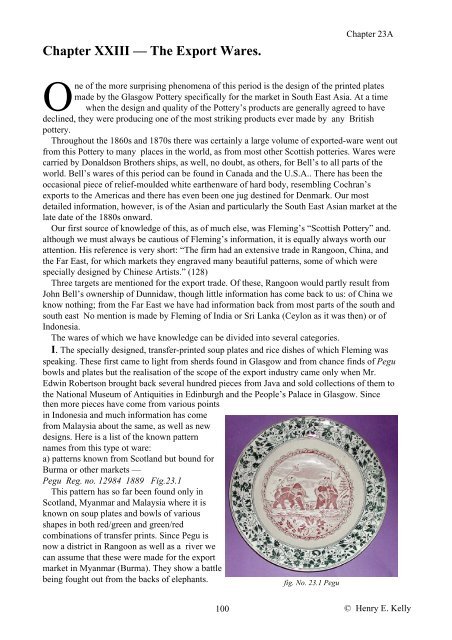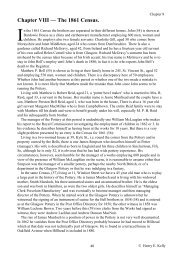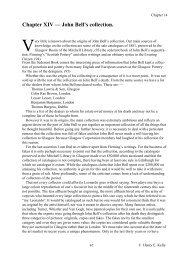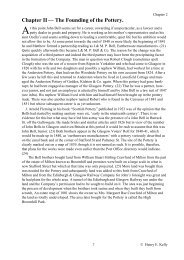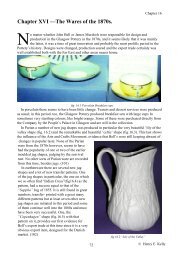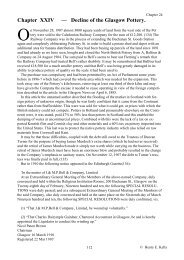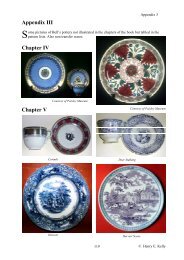Chapter XXIII — The Export Wares. - Bells Glasgow Pottery
Chapter XXIII — The Export Wares. - Bells Glasgow Pottery
Chapter XXIII — The Export Wares. - Bells Glasgow Pottery
You also want an ePaper? Increase the reach of your titles
YUMPU automatically turns print PDFs into web optimized ePapers that Google loves.
<strong>Chapter</strong> <strong>XXIII</strong> <strong>—</strong> <strong>The</strong> <strong>Export</strong> <strong>Wares</strong>.<br />
<strong>Chapter</strong> 23A<br />
One of the more surprising phenomena of this period is the design of the printed plates<br />
made by the <strong>Glasgow</strong> <strong>Pottery</strong> specifically for the market in South East Asia. At a time<br />
when the design and quality of the <strong>Pottery</strong>’s products are generally agreed to have<br />
declined, they were producing one of the most striking products ever made by any British<br />
pottery.<br />
Throughout the 1860s and 1870s there was certainly a large volume of exported-ware went out<br />
from this <strong>Pottery</strong> to many places in the world, as from most other Scottish potteries. <strong>Wares</strong> were<br />
carried by Donaldson Brothers ships, as well, no doubt, as others, for Bell’s to all parts of the<br />
world. Bell’s wares of this period can be found in Canada and the U.S.A.. <strong>The</strong>re has been the<br />
occasional piece of relief-moulded white earthenware of hard body, resembling Cochran’s<br />
exports to the Americas and there has even been one jug destined for Denmark. Our most<br />
detailed information, however, is of the Asian and particularly the South East Asian market at the<br />
late date of the 1880s onward.<br />
Our first source of knowledge of this, as of much else, was Fleming’s “Scottish <strong>Pottery</strong>” and.<br />
although we must always be cautious of Fleming’s information, it is equally always worth our<br />
attention. His reference is very short: “<strong>The</strong> firm had an extensive trade in Rangoon, China, and<br />
the Far East, for which markets they engraved many beautiful patterns, some of which were<br />
specially designed by Chinese Artists.” (128)<br />
Three targets are mentioned for the export trade. Of these, Rangoon would partly result from<br />
John Bell’s ownership of Dunnidaw, though little information has come back to us: of China we<br />
know nothing; from the Far East we have had information back from most parts of the south and<br />
south east No mention is made by Fleming of India or Sri Lanka (Ceylon as it was then) or of<br />
Indonesia.<br />
<strong>The</strong> wares of which we have knowledge can be divided into several categories.<br />
I. <strong>The</strong> specially designed, transfer-printed soup plates and rice dishes of which Fleming was<br />
speaking. <strong>The</strong>se first came to light from sherds found in <strong>Glasgow</strong> and from chance finds of Pegu<br />
bowls and plates but the realisation of the scope of the export industry came only when Mr.<br />
Edwin Robertson brought back several hundred pieces from Java and sold collections of them to<br />
the National Museum of Antiquities in Edinburgh and the People’s Palace in <strong>Glasgow</strong>. Since<br />
then more pieces have come from various points<br />
in Indonesia and much information has come<br />
from Malaysia about the same, as well as new<br />
designs. Here is a list of the known pattern<br />
names from this type ot ware:<br />
a) patterns known from Scotland but bound for<br />
Burma or other markets <strong>—</strong><br />
Pegu Reg. no. 12984 1889 Fig.23.1<br />
This pattern has so far been found only in<br />
Scotland, Myanmar and Malaysia where it is<br />
known on soup plates and bowls of various<br />
shapes in both red/green and green/red<br />
combinations of transfer prints. Since Pegu is<br />
now a district in Rangoon as well as a river we<br />
can assume that these were made for the export<br />
market in Myanmar (Burma). <strong>The</strong>y show a battle<br />
being fought out from the backs of elephants. fig. No. 23.1 Pegu<br />
100 © Henry E. Kelly
) patterns brought back from South East Asia by various people<strong>—</strong><br />
Johore<br />
Peacock and Lilies<br />
Kembang Bintang<br />
Burung Kupu<br />
Malayesque<br />
Tarlalu Bagus<br />
Kalantan<br />
Kalantan<br />
Buah Nanas<br />
Pekin<br />
Burong Supan<br />
Buah Buah<br />
Banda<br />
Dhurian and Nanus<br />
Ikan China<br />
Keelin Hong<br />
Makassar<br />
Borneo<br />
Celebes<br />
Kwantung<br />
Sumatra<br />
Ayam -Jantan<br />
Kapal Basar<br />
Kapal Basar<br />
Dragon<br />
Burong Merak<br />
Sarawak<br />
Malacca<br />
fig. No. 23.2<br />
fig. No. 23.3<br />
fig. No. 23.4<br />
fig. No. 23.5<br />
fig. No. 23.6<br />
fig. No. 23.7<br />
fig. No. 23.8<br />
fig. No. 23.9<br />
fig. No. 23.10<br />
fig. No. 23.11<br />
fig. No. 23.12<br />
fig. No. 23.13<br />
fig. No. 23.14<br />
fig. No. 23.15<br />
fig. No. 23.16<br />
fig. No. 23.17<br />
fig. No. 23.18<br />
fig. No. 23.19<br />
fig. No. 23.20<br />
fig. No. 23.21<br />
fig. No. 23.22<br />
fig. No. 23.23<br />
fig. No. 23.24<br />
fig. No.23.25<br />
Reg. No<br />
Reg. No<br />
Reg. No<br />
Reg. No<br />
Reg. No<br />
Reg. No<br />
Reg. No<br />
Reg. No<br />
Reg. No<br />
Reg. No<br />
Reg. No<br />
Reg. No<br />
Reg. No<br />
Reg. No<br />
Reg. No<br />
Reg. No<br />
Reg. No<br />
Reg. No<br />
Rag, No<br />
Reg. No<br />
Reg. No<br />
Reg. No<br />
Reg. No<br />
Reg. No<br />
Reg. No<br />
Reg. No<br />
Reg. No<br />
83485<br />
83486<br />
87393<br />
87394<br />
88780<br />
102258<br />
112878<br />
118678<br />
115580<br />
118729<br />
128553<br />
131572<br />
131849<br />
136522<br />
138769<br />
139291<br />
147736<br />
149158<br />
158409<br />
162201<br />
164182<br />
174294<br />
184617<br />
192115<br />
331870<br />
413994<br />
455652<br />
1887<br />
1887<br />
1887<br />
1887<br />
1887<br />
1888<br />
1888<br />
1888<br />
1868<br />
1889<br />
1889<br />
1889<br />
1889<br />
1889<br />
1889<br />
1889<br />
1890<br />
1890<br />
1890<br />
1890<br />
1891<br />
1891<br />
1891<br />
1892<br />
1899<br />
1903<br />
1905<br />
<strong>Chapter</strong> 23A<br />
<strong>—</strong> reported from Malaysia<br />
<strong>—</strong> the reg. no. may be<br />
137736<br />
<strong>—</strong> shares border with ‘Pegu’<br />
<strong>—</strong> with checked border<br />
<strong>—</strong> with floral border<br />
Bangkok see Appendix\ 3<br />
Burmania fig. No. 23.26 (page 104<br />
Castile fig. No. 23.29 (page 107)<br />
Humming Bird fig. No. 23.27 (page 106)<br />
Keelung<br />
Maulmain fig. No. 23.28 Reg. No 490180 1906 (page 105) <strong>—</strong> for Burma<br />
Some export patterns designed for the east before 1881 in the Co. period are:<strong>—</strong><br />
Agra Keelung <strong>—</strong> see Appendix 3 also known as Ld.<br />
Alhambra <strong>—</strong> see Appendix 3 Malaga <strong>—</strong> see Appendix 3<br />
Amboina <strong>—</strong> see Appendix 3 Oriental <strong>—</strong> see Appendix 3<br />
Australia Ning-po <strong>—</strong> see Ch. V<br />
Batavia Sexagon<br />
Chinese Sports Siam <strong>—</strong> see Appendix 3<br />
Chinese Villa Trentham<br />
Ching Woosung <strong>—</strong> also known as Ld.<br />
Chusan<br />
Delhi <strong>—</strong> page 111<br />
Japan <strong>—</strong> see Appendix 3<br />
101 © Henry E. Kelly
<strong>Chapter</strong> 23A<br />
All of these make stylistically an astonishingly consistent group aand all are marked with an<br />
impressed B in a bell as well as a garter mark. <strong>The</strong>re are five colours of print used: red, blue,<br />
green, brown and yellow. Specimens are known in single colours and also in combinations of<br />
two colours. Red centres and blue borders or with these colours reversed; red centres with green<br />
borders or with these colours reversed. Blue and green do not occur together nor does brown<br />
occur with any other colour. A very few have yellow as one colour or in combination. Not all the<br />
patterns are known in all these combinations. This is possibly because of the chances of survival<br />
but it may well be that not all the possibilities were fulfilled.<br />
fig. no. 23.2 Johore<br />
Courtesy of Rodger/MacAulay<br />
fig 23.4 Kembang Bintang<br />
Courtesy of Rodger/MacAulay<br />
fig. no.23.3 Peacock & Lillies<br />
Courtesy of Rodger/MacAulay<br />
fig23.5 Burung Kupu<br />
Courtesy of Rodger/MacAulay<br />
102 © Henry E. Kelly
fig. 23.6 Malayesque Courtesy of Werner Troesch<br />
fig. 23.8 Kalantan<br />
fig. 23.10 Pekin<br />
fig. 23.7 Tarlalu Bagus<br />
fig. 23.9 Buah Nanas<br />
<strong>Chapter</strong> 23A<br />
fig. 23.11 Burong Supan. Courtesy of Werner Troesch<br />
103 © Henry E. Kelly
<strong>Chapter</strong> 23A<br />
Fleming does not say where the Chinese who designed these patterns were and it is assumed that<br />
they were somewhere in Asia and the designs were sent here, rather than that the Chinese were<br />
brought to <strong>Glasgow</strong>. <strong>The</strong>re would surely be some trace of a group of Chinese living in <strong>Glasgow</strong><br />
in the late l880s and 1890s. <strong>The</strong>re are, however, certain European elements in the borders of the<br />
designs and it is quite possible that the borders were designed by Bell’s own workmen to go with<br />
the more oriental centres of the plates. <strong>The</strong> plates remain one of the greatest achievements of the<br />
British pottery industry at the turn of the century.<br />
fig. 23.12 Buah Buah fig 23.13 Banda<br />
fig. 23.14 Dhurian and Nanus<br />
fig. 23.15 Ikan China<br />
104 © Henry E. Kelly
fig. 23.16 KeelinHong. Courtesy of Werner Troesch<br />
fig. 23.18 Borneo Courtesy of Werner Troesch<br />
fig. 23. 20 Kwantung<br />
fig. 23.17 Makassar<br />
fig. 23.19 Celebes<br />
fig 23.21 Ayam-Jantan<br />
<strong>Chapter</strong> 23A<br />
105 © Henry E. Kelly
fig. 23.22 Kapal Basar Courtesy of Werner Troesch<br />
fig. 23.24 Burong Merak<br />
fig. 23.26 Burmania<br />
fig.23.23 Dragon<br />
<strong>Chapter</strong> 23A<br />
fig 23.25 Malacca Courtesy of Werner Troesch<br />
fig. 23.27 Humming Bird Courtesy of Rodger/McAulay<br />
106 © Henry E. Kelly
fig 23.28 Mulmain Courtesy of Werner Troesch<br />
<strong>Chapter</strong> 23A<br />
fig 23.29 Castile Courtesy of Rodger/MacAulay<br />
2. <strong>The</strong>re are a number of other later transfer patterns known from Bell’s which have been<br />
found in Malaysia but not from Java. Prominent amongst these is Keelung which shows a vase of<br />
flowers on a ledge in blue and a blue border with C-scrolls. It was noted by Elizabeth McLean<br />
that the impressed mark showed the J to one side of the interior of the bell as if it had been an<br />
earlier JB in a bell with the J removed. Possibly<br />
we have here a purely Scottish design made<br />
use of in an attempt to capture a market in the<br />
area. Also from Malaysia comes <strong>Glasgow</strong><br />
which is a very elegant overall pattern with<br />
fans In dark blue (fig. 23.30). This certainly is<br />
the <strong>Glasgow</strong> pattern since the name occurs<br />
both above and below the garter mark. <strong>The</strong><br />
outer part of the design is almost identical with<br />
a plate illustrated in “Bo’ness Potteries” by<br />
Christine Roberts and Beverly Lyon and<br />
attributed there to Marshall of Bo’ness <strong>Pottery</strong>.<br />
<strong>The</strong> elegance of the Bell’s version is not,<br />
however, achieved in the Bo’ness plate.<br />
Fig. 23.30 <strong>Glasgow</strong><br />
107 © Henry E. Kelly
fig. 23.31 Oppenheimer rice dish<br />
<strong>Chapter</strong> 23A<br />
3. Another type of plate is decorated with hand-painted elements and sponge-printed<br />
elements combined. <strong>The</strong> best knonwn of these are the Oppenheimer plates with the ‘Garden’<br />
pattern on them and a black rubber stamp on the back with the legend “S. OPPENHEIMER &<br />
CO. LTD. RANGOON”. <strong>The</strong>se have been attributed to Bell’s by G. Quail on the basis of sherds<br />
found on a Bell’s dump (figs. 23.31 & 32). (130) A good replica is known from Malaysia with<br />
the mark of Petrus Regout of Maastricht on the<br />
back. Other similar plates have been known<br />
for some time in Scotland. <strong>The</strong>se have a<br />
painted centre with flowers or fruit or with a<br />
hexagon and floral decoration (fig.23.33). <strong>The</strong><br />
range of colour is restricted to crimson, purple,<br />
green and blue. <strong>The</strong>y usually have a border<br />
carefully sponge-printed with a purple motif<br />
and lined in crimson. <strong>The</strong> range of these<br />
patterns reported from Malaysia, India and Sri<br />
Lanka is much greater than that known in<br />
Scotland.<br />
fig.23.32<br />
4. A number of purely sponge-printed<br />
plates of very high quality has also been<br />
reported from Malaysia which bear an<br />
impressed B in a bell (fig.23. 34). Very little<br />
has been seen of this quality at home, though<br />
fig. 23.33<br />
one plate of the type has been illustrated in<br />
Graeme Cruickshank’s book on spongeware (131) and one, in the collection of Huntly House<br />
Museum in Edinburgh, was illustrated on the cover of the present author’s book ‘Scottish<br />
Sponge-Printed <strong>Pottery</strong>’ . (132) <strong>The</strong> range of colour in these plates includes crimson, blue, green.<br />
yellow and grey. It should be emphasised that they are very different products from the<br />
spongeware that was made for the home market or for export to Canada. This latter was a very<br />
basic product intended to cost as little as possible. <strong>The</strong> Asiatic plates are of a very much higher<br />
quality in both design and execution (fig. 23.35).<br />
108 © Henry E. Kelly
fig 23.34<br />
<strong>Chapter</strong> 23A<br />
5. A very small number of purely hand-painted plates has also been reported trom Malaysia.<br />
Curiously these include the use of amber lustre, the famous iron lustre which had been so<br />
popular in Britain and particularly in Scotland in the 1860s and l870s. It is possible that many of<br />
the humble products painted in this colour and now attributed to an early period could date from<br />
rather later than was thought.<br />
c) A magnificent collection of spongeware has been brought back to Britain from Sri Lanka.<br />
(133) This Sri Lanka material displays a wide source of origin. <strong>The</strong> most commonly represented<br />
potteries are <strong>Bells</strong>’ (figs 23.36 & 37) , Methven’s and the Societe Ceramique of Maastricht but<br />
Cochran’s Britannia and Verreville potterles are both represented as well as the Sphinx <strong>Pottery</strong> of<br />
Petrus Regout and Adams of Stoke. <strong>The</strong> style and colouring of all of these makers are<br />
Indistinguishable apart from the backstamps and the vast majority of the pieces are unmarked,<br />
fig. 23.36 <strong>Bells</strong>- Sponged & painted from Sri Lanka<br />
fig 23.35<br />
fig.23.37 <strong>Bells</strong> spongeware from Sri Lanka<br />
109 © Henry E. Kelly
<strong>Chapter</strong> 23A<br />
d) <strong>Wares</strong> have now begun to come back to Scotland from India where <strong>Bells</strong>’ obviously had a<br />
large export trade along with other firms from Scotland. and England. So far what we have seen<br />
from <strong>Bells</strong>’ is sponge-printed wares of high quality only and combinations of sponge-printing<br />
and hand-painting in well known types of pattern (fig.nos. 23.38/39/40). No doubt there are other<br />
wares waiting to be reported.<br />
fig. 23.38 Sponged & painted rice bowl<br />
fig.23.40 Spongeware rice dish<br />
fig.23.39 Sponged & painted rice bowl<br />
110 © Henry E. Kelly
See page 100 for relevant text on Sexagon.<br />
fig. no 23.39 Sexagon in green & brown<br />
Courtesy of Werner Troesch<br />
fig.23.38 Sexagon in blue(see also ch. 16 p. 75)<br />
<strong>Chapter</strong> 23A<br />
Delhi Courtesy of Werner Troesch<br />
111 © Henry E. Kelly


